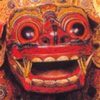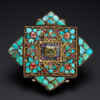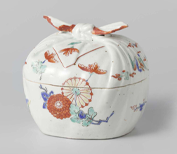XIN XIONG

CHUI TSE-HUNG (Xu Zixiong, born 1936), one of the key figures of Hong Kong’s New Ink Painting Movement, recalled his time sitting in on extramural classes taught by Lui Shou-kwan (Lü Shoukun, 1919–1975) at The Chinese University of Hong Kong in 1969:
Regrettably, I was unable to enrol on the course because there were too many people and the quota was full. I had to give up my seat for new students, and twice I avoided the line by listening to the lesson while sitting in a corner on the stairs outside the classroom. I remember in one session, a student asked if he or she could borrow Mr Lui’s paintings to copy and study at home. Mr Lui tapped on the blackboard and said, “You’ve come to learn painting, not Lui Shou-kwan’s paintings.”
Lui’s other students offered similar accounts. Poon Chun-wah (Pan Zhenhua, born 1936) recounted his first lesson, in which Lui first criticised “the obsolete and rigid malpractice of teaching painting in society” and then lectured on “how to search for the self”. The difference between Lui and the common “malpractice” was best explained by Lawrence Tam (Tan Zhicheng, 1933–2013), who learned from five different ink artists between 1961 and 1966. Everyone else, with the exception of Lui, used the prevalent orthodox method of teaching Chinese painting, which primarily involved copying the teacher’s sketches and paintings.

on paper, 139 x 69 cm. Private collection
Perhaps somewhat coloured by personal sentiments, these recollections nevertheless testify to Lui’s unconventional teaching methods and widespread influence. Born and raised in Guangzhou, Lui Shou-kwan moved to Hong Kong in 1948 — a time when China’s hard-won victory over Japan was succeeded by more civil conflict. After the Second World War, Hong Kong experienced a massive influx of Chinese refugees and immigrants, many of whom, like Lui, had strong ties to China’s cultural legacy. Lui was perfectly capable of painting in the language of China’s high painting traditions, but he instead devoted himself to the modernisation and internationalisation of ink painting, by delving even deeper into its cultural and philosophical roots. His cultural sophistication was exceptional for a rulebreaker, and his innovative nature exceptional for a classical scholar. In his signature “Zen” series, which matured in the late 1960s and early 1970s, Lui combined the visual enchantment of ink with a spiritual experience, symbolised in the form of a lotus bud emerging from a murky pond (1, 2). The appeal of his paintings is immediate, not exclusive to an audience versed in Zen philosophy.
As extraordinary as his artistic individuality was his long-lasting influence through education. Lui died prematurely in 1975, at the age of fifty-six, but his students and admirers continued to invigorate ink painting, turning it into a medium representative of Hong Kong, China and beyond, in the face of increased global contact and the need for self-positioning. They even anticipated Chinese artists on the mainland, who largely had to wait until the end of the 1970s for their cultural policies to relax. Most commonly known as “new ink” painters, they pushed the medium well beyond its traditional boundaries, incorporating in their unique ways non-representational shapes, design elements, artificial colours, personal fantasies, calligraphy, or even non-ink mediums, just to name a few (3).

What do we make of the diverse individualities of new ink painters who once took lessons from Lui Shou-kwan? How did Lui’s influence extend past his artistic production? In which ways did his ideas and teaching methods inspire what came after? To answer these questions, we must look beyond Lui’s own artistic output and into the less-studied part of his life as an art educator. This article begins with Lui’s early teaching experiences, then moves on to his later role in post-secondary art education, and finally zooms in on his systematic teaching approach that inspired a new generation of ink painters.
Early Years as a Teacher
Lui Shou-kwan began his teaching career in 1958, a mere twelve years after he set out to become an artist. According to his close student, Wucius Wong (Wang Wuxie, born 1936), Lui often characterised himself as a self-taught artist, despite the fact that he may have received instruction from his artist-father, Lui Tsan-ming (Lü Canming, 1892–1963). In one of his earliest surviving paintings, Rabbits, dated 1948, Lui included a lengthy inscription, in which he argued that copying authentic ancient paintings was preferable to studying under contemporary masters (4):
The masters Chang [Dai-chien] and Yu [Fei’an] fail to grasp the methods and essences of Song painting while Zhao [Haogong] and Lu [Zhenhuan] its spirit. A novice like me can by no means be compared with these masters. Since Song paintings can still be seen today, I should not thoughtlessly study under anyone simply because they have a big name.
From the very beginning, Lui displayed a critical attitude towards art tutoring. His candid assessment of well established artists was unusual for a young artist, but it revealed his earnestness to gain first-hand knowledge of classical styles rather than second-hand interpretations. Lui considered “all painters from the past” as his teachers, but also made it clear that to learn was not to become a follower.



In the latter half of the 1950s, around ten years into his journey as an artist, Lui began consciously to depart from classical styles and experiment with abstract forms and non-representational colours (5). In an early interview, Lui acknowledged the impact that contemporary art trends had on him, but he had no intention of becoming a trend follower. What he wanted was to arrive at his individual self, free from the influence of his previous learning.
Around the time Lui embarked on his self-searching journey, he also began to admit students. Wucius Wong, a seminal new ink artist with his own sphere of influence, became one of the first students in 1958 to take lessons at Lui’s home. Lui’s educational activities were not limited to private tutoring. In the autumn of 1958, the Chung Shan Secondary School invited Lui to direct its newly launched art curriculum for adults. He taught evening classes there three times a week until May 1962. The curriculum was likely limited in scope, but its institutional tie gave it a place in the history of art education in Hong Kong.
In the first part of the 20th century, art education in Hong Kong was primarily left to the whims of individuals, who spread their influence by opening studios and private schools. Programmes and institutions with greater official backing began to emerge in the 1950s, initiating a shift towards better cultural infrastructure in the decades that followed. Zheng Chunting, writing in 1959, introduced the Chung Shan art curriculum as a response to the official call to modernise art education and highlighted Lui’s potential role in the movement of “new art education”.

Not much is known about how Lui delivered his early lessons, but surviving evidence reveals his enthusiasm for formal experiments and support for individual creativity. In April 1959, when Lui and four of his pupils held a joint exhibition, the press called them the “new art school” (xinyi pai), which “inherited China’s precious art legacy while embracing ideas of Western painting” (6). Lui wrote, in one of his diaries, that the “new art school” was not a school under his influence, but belonged to everyone with individual creativity. A number of Lui’s paintings from the late 1950s were painted at the “new art studio”, presumably Lui’s personal studio from which the name “new art school” was derived. In the painting, Synthesis of Light, Lui emphasised the importance of subjectivity, writing that the colours that he painted were the result of two light sources, the “light of nature” and the “light of the mind” (7).
Pat Hui (Xu Xuebi, born 1943) further gives a lively account of her teacher at Chung Shan from the early 1960s, which testifies to Lui’s interest in formal abstraction, as well as his broad learning:
My most enduring impression of Mr Lui at the Chung Shan studio was his painting demonstration from beginning to end. Within two hours, a sheet of white paper was transformed into a landscape covered in mist and rain, or an abstract painting with powerful lines and rich colours.
After class, Mr Lui and I walked to the Wan Chai pier via Stubbs Road. On the way, Mr Lui talked mostly about art, literature, philosophy, politics, economics and even films, both ancient and contemporary, Chinese and foreign. That period of my life broadened my interests and paved the way for my later pursuits of poetry, calligraphy and painting.

A line drawing now in the Ashmolean Museum provides additional insight into Lui’s non-traditional teaching methods. Instead of confining his students to classroom learning, he took them on sketching tours and probably encouraged them to find individual formal expression in nature. In his own case, he roamed freely between past and present, trying to discover in his own sketches a lively quality in line — a concern widely shared by Chinese painters of the past (8). Lui wrote on the painting:
On a foggy night in November 1961, I hiked up Victoria Peak with students from Chung Shan. Along the way, we practised sketching using lines. After we returned, I tidied the sketches up, but somehow felt they lacked vitality.
Not long after leaving Chung Shan in 1962, Lui began to give private lessons at the newly opened Chatham Gallery. Leung Kui-ting (Liang Juting, born 1945) recalled that his teacher-student relationship with Lui started at Chatham in early 1964. It then continued at the newly established Department of Extramural Studies at The Chinese University of Hong Kong, as Lui was recruited as one of its first art teachers. 1965 marked the beginning of a new era in Lui’s teaching career. He quit his full-time job at the Hong Kong and Yaumati Ferry Company, where he had worked as an inspector since 1949, and became a fully dedicated artist and teacher. Lui’s personal history coincided with arguably Hong Kong’s first post-war art boom. As Lui established his pedagogy at higher education institutions, such as the Hong Kong University (HKU) and The Chinese University of Hong Kong (CUHK), ink painting in Hong Kong also entered a new phase of development.

Teaching at CUHK and HKU
For Lui Shou-kwan, the first half of the 1960s was a time of great achievement and recognition. Not only did he find a highly individual expression in painting, but he also became well established through a series of domestic and international exhibitions. In May 1963, the recently opened Commonwealth Institute in London welcomed him as one of the first artists to be exhibited (9). In November 1964, Lui further solidified his artistic position in Hong Kong by having a solo exhibition at the City Hall Museum and Art Gallery, the only official exhibition space at the time (10). No doubt, his growing reputation as an artist garnered the notice of higher education institutions looking to expand their then-nascent art programmes.

In 1965, HKU’s Department of Architecture invited Lui to instruct its first and second-year students in Chinese painting for the entire academic year. The fact that he was chosen by an architecture programme says a lot about his achievement as a visual artist. H.G. Hollmann, the former acting head of the department, requested in a letter to Lui that he teach “basic theories” of Chinese painting “without getting lost in a dead traditionalism and instead encouraging a more free [sic] expression as it is admirably achieved in your [his] paintings”. The job offer was extended through the mid-1970s. It is not known how Lui taught during his first year at HKU, but by 1966, he was employing a formalist approach based on the basic elements of “points, lines, surfaces, and bodies”.
While this approach would have best suited a comprehensive architecture programme, Lui also applied it to other ink painting courses that trained artists and art teachers rather than architects.
In 1965, when HKU offered Lui a teaching position, CUHK established its Department of Extramural Studies and asked Lui to teach the course, “Tradition and Technique in Chinese Art”. For this course, Lui used more than 600 slides of paintings from his own collection, and compiled tens of thousands of characters of lecture notes on painting history. The following year, Lui designed a new extramural course entitled “Ink Painting”. The significance of this new course cannot be overemphasised. As it evolved into a regular programme, it also became a training ground for a new generation of ink experimenters in Hong Kong.

The change in name from “Chinese painting” to “ink painting” warrants attention here, since it closely reflects Lui’s personal vision. In a public seminar that took place in 1972, he first criticised the imitative practice in “Chinese painting” and then called for development of “ink painting” as an artistic category that transcended national boundaries despite its rich Chinese heritage:
In the same way that “oil painting” includes works from the United Kingdom, France, the Netherlands, Germany, Italy and other countries, “ink painting” in the future will embrace works from China, Japan, Southeast Asia, Europe and the United States. Even within China, there may be north-south differences based on factors such as region, culture and background. In all categories of painting, this phenomenon occurs inevitably. For this reason, “ink painting” can be seen either as a subgenre of Chinese painting, much like a son to a mother, or as a category of painting not limited to the Chinese.

As Lui promoted the global appeal of ink painting, his students at CUHK formed a formidable force in the creation of new ink paintings. Many of them became quickly established, either as artists representative of Hong Kong or as teachers in schools and universities. Two groups were the most prominent: the In Tao Art Association was created in 1967 while its members were still taking Lui’s classes; the One Art Group was founded in 1970 and remained active until the 21st century despite a period of inactivity.
Lui’s impact on his students was felt more through method, idea and philosophy than through practice. Apart from “Ink Painting”, Lui taught a variety of other extramural courses at CUHK between 1965 and 1973, including “Painting from Life”, “History of Chinese Painting” and “Traditional Techniques in Chinese Landscape Painting”. Different courses, with a focus on either creativity or knowledge, practice or theory, could be taken separately or in conjunction with one another. The history course, for instance, complemented the practice-based course on traditional techniques. Depending on the year and programme, ink art practice was taught over multiple courses or in a single, more comprehensive one. Lui liked to use the word “trigger” (chufa) to justify his different approaches to teaching. Students could be triggered by nature, his own ink painting system, history and tradition, or different painting materials.

In any case, Lui always prompted his students to think about their purpose and to distinguish between learning and creating. Copying may be part of the learning process, but never should it be mistaken for creating. Lui cautioned students against learning from his paintings, including his copies of the ancients. To teach ink painting, Lui used the fundamental elements of “points, lines, surfaces, and bodies” and demonstrated these elements with simple drawings and diagrams (11). To teach traditional techniques, Lui instructed students to study and copy photographic reproductions of the originals; he only showed his copies in class after students had done their ones. Kan Tai-keung (Jin Daiqiang, born 1942) kept one of the copying exercises on which Lui wrote his feedback (12). Apart from technical details, Lui advised Kan on how to proceed with his studies, which should begin with…
Click here to access Arts of Asia‘s Spring 2024 issue for the full article.

 Subscribe
Subscribe Calendar
Calendar Links
Links Gift
Gift


